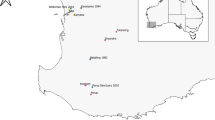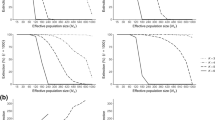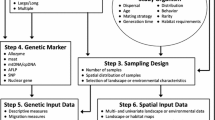Abstract
The concept of minimum populations of wildlife and plants has only recently been discussed in the literature. Population genetics has emerged as a basic underlying criterion for determining minimum population size. This paper presents a genetic framework and procedure for determining minimum viable population size and dispersion strategies in the context of multiple-use land management planning. A procedure is presented for determining minimum population size based on maintenance of genetic heterozygosity and reduction of inbreeding. A minimum effective population size (N e ) of 50 breeding animals is taken from the literature as the minimum shortterm size to keep inbreeding below 1% per generation. Steps in the procedure adjustN e to account for variance in progeny number, unequal sex ratios, overlapping generations, population fluctuations, and period of habitat/population constraint. The result is an approximate census number that falls within a range of effective population size of 50–500 individuals. This population range defines the time range of short- to long-term population fitness and evolutionary potential. The length of the term is a relative function of the species generation time. Two population dispersion strategies are proposed: core population and dispersed population.
Similar content being viewed by others
Literature cited
Avery, P. J. 1978. The effects of finite population size on models of linked overdominant loci.Genet. Res. Camb. 31:239–254.
Bonnell, M. L., and R. K. Selander. 1974. Elephant seals: genetic variation and near extinction.Science 184:908–909.
Cameron, D. G., and E. R. Vyse. 1978. Heterozygosity in Yellowstone Park elkCervus canadensis. Biochem. Genetics 16(7–8):651–657.
Chapman, F. M. 1925. The European starling as an American citizen.Nat. Hist. 25:480–485.
Connolly, G. E. 1981. Trends in populations and harvests. Pages 225–244in O. C. Wallmo, ed. Mule and black-tailed deer of North America. University of Nebraska Press, Lincoln, NE.
Craighead, J. J., J. Varney, and F. C. Craighead, Jr. 1974. A population analysis of the Yellowstone grizzly bears. Montana Forest and Conservation Experiment Station Bulletin 40. University of Montana, Missoula, MT.
Crow, J. F., and N. E. Morton. 1955. Measurement of gene frequency drift in small populations.Evolution 9:202–214.
Denniston, C. 1977. Small population size and genetic diversity: implications for endangered species. Pages 281–289in S. A. Temple, ed. Endangered birds: management techniques for preserving threatened species. University of Wisconsin Press, Madison, WI.
Ehrlich, P., and A. Ehrlich. 1981. Extinction: the causes and consequences of the disappearance of species. Random House, New York, NY. 303 pp.
Endangered Species Technical Bulletin. 1979. Special report: last ditch contingency plan seen as only hope for California condor. US Department of Interior, Fish and Wildlife Service. Endangered Species Program, Washington, DC. 6 pp.
Falconer, D. S. 1960. Introduction to quantitative genetics. Ronald Press, New York, NY. 365 pp.
Frankel, O. H., and M. E. Soulé. 1981. Conservation and evolution. Cambridge University Press, New York, NY. 327 pp.
Franklin, I. R. 1980. Evolutionary change in small populations. Pages 135–149in M. E. Soulé and B. A. Wilcox, eds. Conservation biology: an evolutionary-ecological approach. Sinauer Assoc., Sunderland, MA.
Greenwood, P. J., P. H. Harvey, and C. M. Perrins. 1978. Inbreeding and dispersal in the great tit.Nature 271:52–54.
Hoogland, J. L. 1982. Prairie dogs avoid extreme inbreeding.Science 215:1638–1641.
Kessel, B. 1953. Distribution and migration of the European starling in North America.Condor 55:49–68.
Kornfield, I., K. F. Beland, J. R. Moring, and F. W. Kircheis. 1981. Genetic similarity among Arctic char (Salvelinus alpinus) and implications for their management.Can. J. Fish. Aquat. Sci. 38:32–39.
Lovejoy, T. E. 1977. Genetic aspects of dwindling populations: a review. Pages 275–279in S. A. Temple, ed. Endangered birds: management techniques for preserving threatened species. University of Wisconsin Press, Madison, WI.
MacDonald, D., and R. A. Jantzen. 1967. Management of the Merriam's Turkey. Pages 483–534in O. H. Hewitt, ed. The wild turkey and its management. The Wildlife Society, Washington, DC.
McCullough, D. R. 1979. The George Reserve deer herd. University of Michigan Press, Ann Arbor, MI. 271 pp.
Manlove, M. N., R. Baccus, M. R. Pelton, M. H. Smith, and D. Gruber. 1980. Protein variation in black bear populations. Pages 37–41in C. J. Martinka and K. L. McArthur, eds. Proceedings of 4th International Conference on Bear Research and Management, 1977. Bear Biologists Association, Missoula, MT.
Mealey, S. P., and J. R. Horn. 1981. Integrating wildlife habitat objectives into the Forest plan.Trans. N. Amer. Wildl. and Natur. Resour. Conf. 46:488–500.
Morgan, R. P. II, J. A. Chapman, L. A. Noe, and C. J. Henny. 1974. Electrophoresis as a management tool. Pages 63–71in Trans. N.E. Fish and Wildlife Conf.
Myers, N. 1979. The sinking ark. Pergamon Press, Elmsford, NY. 307 pp.
Nei, M., T. Maruyama, and R. Chakraborty. 1975. The bottleneck effect and genetic variability in populations.Evolution 29(1):1–10.
Packer, C. 1979. Inter-troop transfer and inbreeding avoidance inPapio anubis.Anim. Behav. 27(1):1–36.
Patton, D.R. 1982. Wildlife habitat in land management planning: some ideas and principles. Pages 33–38in Proc. of the workshop: The effects of land management practices on fish and wildlife in southwestern conifer forests. Tucson, AZ, Feb. 16–17,1982. School of Renewable Natural Resources, University of Arizona, Tucson, AZ.
Peterson, L. E., and A. H. Richardson. 1973. Merriam's wild turkey in the Black Hills in South Dakota. Pages 3–10in G. C. Sanderson, and H. C. Schultz, eds. Wild turkey management: current problems and programs. University of Missouri Press, Columbia, MO.
Ralls, K., K. Brugger, and J. Ballou. 1979. Inbreeding and juvenile mortality in small populations of ungulates.Science 206:1101–1103.
Ryman, N., R. Baccus, C. Reuterwall, and M. H. Smith. 1981. Effective population size, generation interval, and potential loss of genetic variability in game species under different hunting regimes.Oikos 36(3):257–266.
Ryman, N., G. Beckman, G. Bruun-Peterson, and C. Reuterwall. 1977. Variability of red cell enzymes and genetic implications of management policies in Scandinavian mouse (Alces alces).Hereditas 85:157–165.
Seal, U. S. 1977. The Noah's Ark problem: multigenerational management of wild species in captivity. Pages 303–313in S. A. Temple, ed. Endangered birds: management techniques for preserving threatened species. University of Wisconsin Press, Madison, WI.
Selander, R. K., and D. Kaufman. 1973. Self-fertilization and genetic population structure in a colonizing land snail.Proc. Nat. Acad. Sci. 70:1186–1190.
Selander, R. K., D. W. Kaufman, R. J. Baker, and S. L. Williams. 1975. Genic and chromosomal differentiation in pocket gophers of theGeomys sursarius group.Evolution 28:557–564.
Senner, J. W. 1980. Inbreeding depression and the survival of zoo populations. Pages 209–224in M. E. Soulé and B. A. Wilcox, eds. Conservation biology: an evolutionary-ecological approach. Sinauer Assoc, Sunderland, MA.
Shaffer, M. L. 1978. Determing minimum viable population sizes: a case study of the grizzly bear (Ursus arctos L.). Ph.D. Dissertation, Duke University, Durham, NC. 206 pp.
Shaffer, M. L. 1981. Minimum population sizes for species conservation.BioScience 31 (2):131–134.
Short, H. L. 1979. Deer in Arizona and New Mexico: their ecology and a theory explaining recent population decreases. US Department of Agriculture Forest Service, Gen. Tech. Rep. RM-70, Rocky Mt. For. and Range Exp. Sta., Fort Collins, CO. 25 p.
Smith, M. H., H. O. Hillestad, M. N. Manlove, and R. L. Marchinton. 1976. Use of population genetics data for the management of fish and wildlife populations.Trans. N. Amer. Wildl. and Natur. Resour. Conf. 41:119–131.
Soulé, M. E. 1980. Thresholds for survival: maintaining fitness and evolutionary potential. Pages 151–169in M. E. Soulé and B. A. Wilcox, eds. Conservation biology: an evolutionary-ecological perspective. Sinauer Assoc., Sunderland, MA.
Trefethen, J. B., ed. 1975. The wild sheep in modern North America. Boone and Crocket Club and Winchester Press, New York, NY. 302 pp.
Utter, F. M., F. W. Allendorf, and H. O. Hodgins. 1973. Genetic variability and relationships in Pacific salmon and related trout based on protein variations.Syst. Zool. 22(2):257–270.
Utter, F. M., F. W. Allendorf, and B. May. 1976. The use of protein variation in the management of salmonid populations.Trans. N. Amer. Wildl. Natur. Resour. Conf. 41:373–384.
Watts, T., and W. Conley. 1981. Extinction probabilities in a remnant population ofOvis canadensis mexicana.Acta Theriol. 26:393–405.
Wright, S. 1983. Evolution in Mendelian populations.Genetics 16:97–159.
Author information
Authors and Affiliations
Rights and permissions
About this article
Cite this article
Lehmkuhl, J.F. Determining size and dispersion of minimum viable populations for land management planning and species conservation. Environmental Management 8, 167–176 (1984). https://doi.org/10.1007/BF01866938
Issue Date:
DOI: https://doi.org/10.1007/BF01866938




